Automated CT and MRI Liver Segmentation and Biometry Using a Generalized Convolutional Neural Network
- PMID: 32582883
- PMCID: PMC7314107
- DOI: 10.1148/ryai.2019180022
Automated CT and MRI Liver Segmentation and Biometry Using a Generalized Convolutional Neural Network
Abstract
Purpose: To assess feasibility of training a convolutional neural network (CNN) to automate liver segmentation across different imaging modalities and techniques used in clinical practice and apply this to enable automation of liver biometry.
Methods: We trained a 2D U-Net CNN for liver segmentation in two stages using 330 abdominal MRI and CT exams acquired at our institution. First, we trained the neural network with non-contrast multi-echo spoiled-gradient-echo (SGPR)images with 300 MRI exams to provide multiple signal-weightings. Then, we used transfer learning to generalize the CNN with additional images from 30 contrast-enhanced MRI and CT exams.We assessed the performance of the CNN using a distinct multi-institutional data set curated from multiple sources (n = 498 subjects). Segmentation accuracy was evaluated by computing Dice scores. Utilizing these segmentations, we computed liver volume from CT and T1-weighted (T1w) MRI exams, and estimated hepatic proton- density-fat-fraction (PDFF) from multi-echo T2*w MRI exams. We compared quantitative volumetry and PDFF estimates between automated and manual segmentation using Pearson correlation and Bland-Altman statistics.
Results: Dice scores were 0.94 ± 0.06 for CT (n = 230), 0.95 ± 0.03 (n = 100) for T1w MR, and 0.92 ± 0.05 for T2*w MR (n = 169). Liver volume measured by manual and automated segmentation agreed closely for CT (95% limit-of-agreement (LoA) = [-298 mL, 180 mL]) and T1w MR (LoA = [-358 mL, 180 mL]). Hepatic PDFF measured by the two segmentations also agreed closely (LoA = [-0.62%, 0.80%]).
Conclusions: Utilizing a transfer-learning strategy, we have demonstrated the feasibility of a CNN to be generalized to perform liver segmentations across different imaging techniques and modalities. With further refinement and validation, CNNs may have broad applicability for multimodal liver volumetry and hepatic tissue characterization.
Conflict of interest statement
Figures
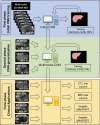
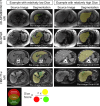
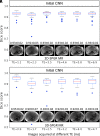




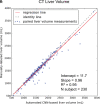
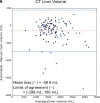
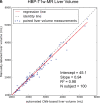
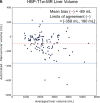
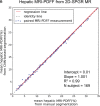
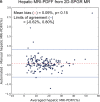
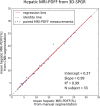
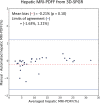
Similar articles
-
Channel width optimized neural networks for liver and vessel segmentation in liver iron quantification.Comput Biol Med. 2020 Jul;122:103798. doi: 10.1016/j.compbiomed.2020.103798. Epub 2020 May 16. Comput Biol Med. 2020. PMID: 32658724
-
Automated segmentation of the human supraclavicular fat depot via deep neural network in water-fat separated magnetic resonance images.Quant Imaging Med Surg. 2023 Jul 1;13(7):4699-4715. doi: 10.21037/qims-22-304. Epub 2023 Mar 14. Quant Imaging Med Surg. 2023. PMID: 37456284 Free PMC article.
-
Cascaded deep learning-based auto-segmentation for head and neck cancer patients: Organs at risk on T2-weighted magnetic resonance imaging.Med Phys. 2021 Dec;48(12):7757-7772. doi: 10.1002/mp.15290. Epub 2021 Nov 1. Med Phys. 2021. PMID: 34676555
-
Deep learning from dual-energy information for whole-heart segmentation in dual-energy and single-energy non-contrast-enhanced cardiac CT.Med Phys. 2020 Oct;47(10):5048-5060. doi: 10.1002/mp.14451. Epub 2020 Aug 27. Med Phys. 2020. PMID: 32786071
-
Automated cartilage segmentation and quantification using 3D ultrashort echo time (UTE) cones MR imaging with deep convolutional neural networks.Eur Radiol. 2021 Oct;31(10):7653-7663. doi: 10.1007/s00330-021-07853-6. Epub 2021 Mar 30. Eur Radiol. 2021. PMID: 33783571 Free PMC article.
Cited by
-
Artificial intelligence development in pediatric body magnetic resonance imaging: best ideas to adapt from adults.Pediatr Radiol. 2022 Feb;52(2):367-373. doi: 10.1007/s00247-021-05072-1. Epub 2021 Apr 13. Pediatr Radiol. 2022. PMID: 33851261 Free PMC article. Review.
-
Augmenting Interpretation of Chest Radiographs With Deep Learning Probability Maps.J Thorac Imaging. 2020 Sep;35(5):285-293. doi: 10.1097/RTI.0000000000000505. J Thorac Imaging. 2020. PMID: 32205817 Free PMC article.
-
When liver disease diagnosis encounters deep learning: Analysis, challenges, and prospects.ILIVER. 2023 Mar 4;2(1):73-87. doi: 10.1016/j.iliver.2023.02.002. eCollection 2023 Mar. ILIVER. 2023. PMID: 40636411 Free PMC article. Review.
-
Deep Learning Algorithm for Automated Segmentation and Volume Measurement of the Liver and Spleen Using Portal Venous Phase Computed Tomography Images.Korean J Radiol. 2020 Aug;21(8):987-997. doi: 10.3348/kjr.2020.0237. Korean J Radiol. 2020. PMID: 32677383 Free PMC article.
-
Artificial Intelligence-powered automatic volume calculation in medical images - available tools, performance and challenges for nuclear medicine.Nuklearmedizin. 2023 Dec;62(6):343-353. doi: 10.1055/a-2200-2145. Epub 2023 Nov 23. Nuklearmedizin. 2023. PMID: 37995707 Free PMC article. Review.
References
-
- Kessler LG, Barnhart HX, Buckler AJ, et al. . The emerging science of quantitative imaging biomarkers terminology and definitions for scientific studies and regulatory submissions. Stat Methods Med Res 2015;24(1):9–26. - PubMed
-
- Joo S, Yang YS, Moon WK, Kim HC. Computer-aided diagnosis of solid breast nodules: use of an artificial neural network based on multiple sonographic features. IEEE Trans Med Imaging 2004;23(10):1292–1300. - PubMed
-
- Farraher SW, Jara H, Chang KJ, Hou A, Soto JA. Liver and spleen volumetry with quantitative MR imaging and dual-space clustering segmentation. Radiology 2005;237(1):322–328. - PubMed
Grants and funding
LinkOut - more resources
Full Text Sources
Other Literature Sources

